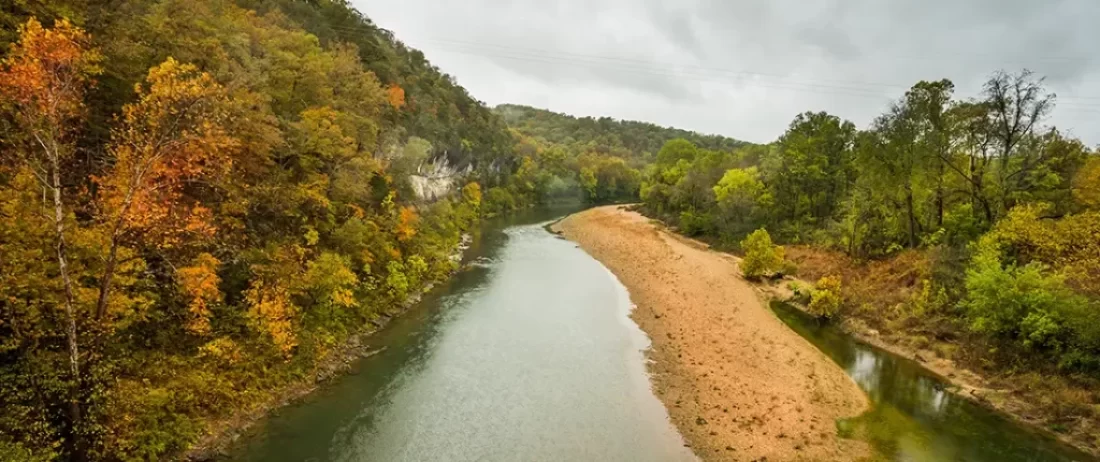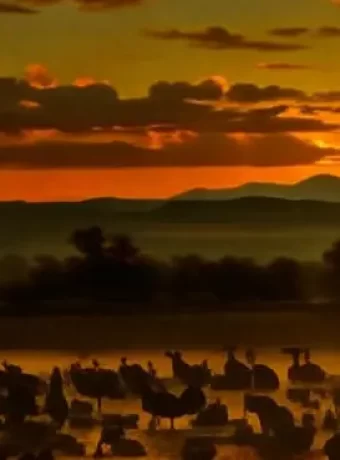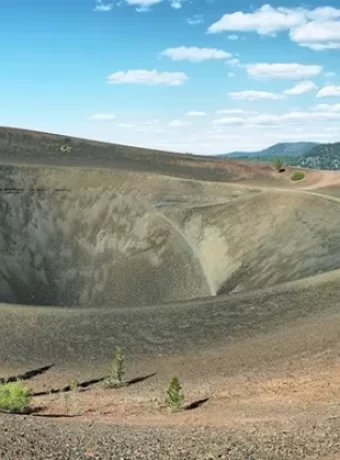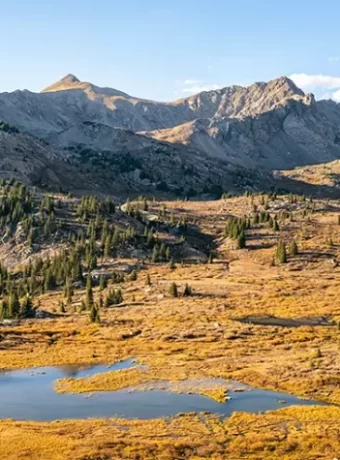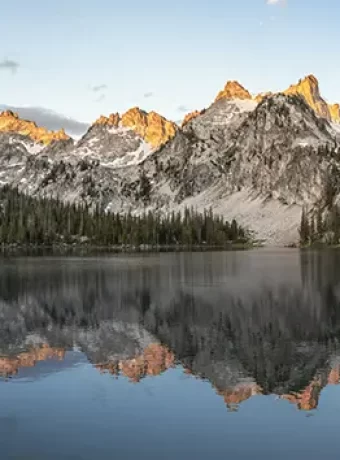Exploring the Buffalo National River Wilderness (NPS) and Upper Buffalo Wilderness (USFS)
The Buffalo National River Wilderness (NPS) and Upper Buffalo Wilderness (USFS) are two of America’s most cherished natural treasures, each with a rich history spanning decades of conservation efforts and public enjoyment. The History of Buffalo National River Wilderness (NPS) and Upper Buffalo Wilderness (USFS) is a compelling tale of preservation, community involvement, and the persistent effort to balance human use with environmental protection. As we look into the past and present of these magnificent wilderness areas, we’ll uncover the stories that shaped their existence and continue to influence their future management by the National Park Service and the Forest Service.
The Buffalo River, often called the crown jewel of Arkansas and a significant tributary to the White River system, has been carving its way through the Ozark Mountains for millions of years, creating stunning bluffs and a diverse ecosystem. It’s the more recent history—the last century or so—that defined these wilderness areas as we know them today, transitioning from settled lands to protected public recreation areas. From the early settlers who recognized the river’s beauty and potential to the modern-day adventurers seeking solitude and adventure on its waters and hiking trails, the Buffalo has always held a special place in the hearts of those who experience its wonders.
Join us as we explore the fascinating History of Buffalo National River Wilderness (NPS) and Upper Buffalo Wilderness (USFS), from their geological beginnings and early human history to their status as a premier scenic river and designated wilderness. We’ll uncover the challenges faced, the conservation triumphs celebrated, and the ongoing efforts by the park service and national forest managers to preserve these natural wonders. Understanding this history provides context for the current management practices and future possibilities for the Buffalo River area.
Table of Contents
The Early Years: Before Wilderness Designation
Long before the Buffalo National River and Upper Buffalo Wilderness areas received official protection, the region served as a vital home and resource area. Native American tribes and, later, European settlers utilized the rich river valley. The river and surrounding Ozark National Forest lands provided sustenance and shelter, with inhabitants recognizing the area’s natural bounty and rugged beauty.
Native American Presence
Archaeological evidence indicates a long history of human occupation in the Buffalo River valley, stretching back thousands of years. Various Native American tribes, including the Osage who dominated the region during early European contact and later displaced groups like the Cherokee, inhabited or frequented the area. These indigenous peoples adapted to the landscape, utilizing rock shelters for habitation and leaving behind artifacts like tools, pottery, and rock art that offer glimpses into their way of life and deep connection to the land.
These sites, some of which are listed on the National Register of Historic Places, are fragile reminders of this long human presence. They underscore the importance of protecting not just the natural environment but also the cultural heritage embedded within the Buffalo River area. The park service works diligently to preserve these resources while allowing for respectful interpretation.
European Settlement
Beginning in the early 19th century, European-American settlers, primarily migrating from Appalachia, began moving into the remote Ozark region, including the Buffalo River valley in Newton County and Searcy County. They sought land for farming and established small, often isolated homesteads along the river and its tributaries, like Spring Creek. They cleared forests for small subsistence farms, built grist mills using the river’s power, and began harvesting timber, gradually altering the landscape.
Life was challenging due to the rugged terrain, poor road conditions, and limited access to markets. Communities remained small, and many historic structures, like the Collier Homestead near Tyler Bend, still stand today, offering insight into the settlers’ resilience and way of life. Despite settlement and activities like logging, large portions of the area remained relatively wild due to their remoteness, setting the stage for later conservation efforts.
The Civil War also left its mark on the Buffalo River valley, with divided loyalties leading to local conflict and bushwhacking. The disruption and hardship of the war further shaped the settlement patterns and cultural landscape of the region. Post-war recovery was slow, and the area remained sparsely populated for decades.

Get Lost in Montana-Musky Fly Fish and More
The Road to Conservation: Early 20th Century
As the 20th century unfolded, a growing national awareness regarding the importance of conservation began to take hold. This movement significantly influenced the future of the Buffalo River region. Early efforts to protect its unique natural beauty and prevent detrimental development started gaining crucial momentum, driven by both local advocates and national trends.
The Civilian Conservation Corps Era
During the severe economic downturn of the Great Depression in the 1930s, the Civilian Conservation Corps (CCC) became a pivotal force in the area. This federal program provided employment while developing infrastructure within public lands, including parts of the Ozark National Forest adjacent to the future national river. CCC workers undertook significant projects that enhanced recreational access and facilities.
They constructed trails, built campgrounds like the one at Buffalo Point, erected shelters, and improved roads, making the scenic river area more accessible for public enjoyment. Much of this infrastructure, built with local materials and rustic design principles, laid the groundwork for the recreational facilities visitors use today within the Buffalo National River. The legacy of the Conservation Corps remains visible and appreciated throughout the park.
Early Preservation Efforts
By the 1960s, the primary threat to the Buffalo River’s natural state emerged: proposals to construct hydroelectric dams along its course. These proposals galvanized opposition from local conservationists, outdoorsmen, scientists, and concerned citizens who valued the river’s free-flowing character and scenic beauty. They feared dams would inundate significant portions of the river valley, destroying habitat, displacing residents, and eliminating recreational opportunities like floating.
Organizations like The Ozark Society, founded specifically to fight the dams, played a crucial role in raising public awareness and advocating for protection. Figures like Dr. Neil Compton became champions for the cause, arguing for the river’s preservation based on its unique ecological and aesthetic qualities. This grassroots movement, coupled with political support, ultimately proved successful, shifting the focus from development towards establishing permanent protection for the Buffalo River.
Birth of the Buffalo National River: 1972
The year 1972 represents a watershed moment in the History of Buffalo National River Wilderness (NPS) and Upper Buffalo Wilderness (USFS). After years of debate and advocacy, a major conservation victory was achieved. On March 1, 1972, President Richard Nixon signed Public Law 92-237, establishing the Buffalo National River as America’s very first national river, a designation managed by the National Park Service.
A Groundbreaking Designation
Creating the Buffalo National River was a landmark achievement, setting a precedent for river conservation nationwide. The designation protected a 135-mile corridor along the Buffalo River, safeguarding it from dam construction and incompatible development. This ensured the preservation of its free-flowing character, stunning bluffs, clear water, and surrounding natural landscape for public benefit and future generations.
This novel “national river” designation acknowledged the unique recreational, scenic, and ecological values of a river system. It provided a framework for managing the river corridor differently than a traditional national park, focusing on preserving the river itself while allowing compatible recreation. The Francis National Forest continued managing adjacent lands, creating a complex interagency landscape.
Initial Challenges
The early years following the Buffalo National River’s establishment presented numerous hurdles for the National Park Service. A primary task involved acquiring land within the designated boundaries, often from unwilling sellers, leading to complex negotiations and sometimes contentious relationships with local landowners in Newton County, Searcy County, and Marion County. Developing comprehensive management plans that balanced conservation mandates with visitor use and the needs of existing communities was another significant undertaking.
Establishing infrastructure, including visitor centers like the one at Tyler Bend, ranger stations, campgrounds, and river access points like Steel Creek and Pruitt, required substantial effort and funding. Setting regulations for river use, managing hunting and fishing according to state laws but within park boundaries, and addressing issues like water quality required careful planning. Despite these initial difficulties, the park quickly gained popularity, attracting visitors eager to experience the beauty of this newly protected scenic river.
Wilderness Designation: 1978
Just six years after the Buffalo National River was established, another crucial layer of protection was added, further solidifying the conservation legacy in the History of Buffalo National River Wilderness (NPS) and Upper Buffalo Wilderness (USFS). Congress passed legislation designating specific lands within and adjacent to the national river corridor as part of the National Wilderness Preservation System.
Buffalo National River Wilderness
In 1978, Congress officially designated the Buffalo National River Wilderness, managed by the National Park Service. This wilderness area initially encompassed approximately 10,500 acres but was later expanded through subsequent legislation, bringing the total to 34,933 acres spread across three distinct units: the Ponca Unit, the Buffalo Unit (sometimes called the Middle Unit), and the Lower Buffalo Unit. These units protect some of the most remote, rugged, and ecologically significant sections along the river.
Wilderness designation provides the highest level of federal land protection, prohibiting motorized vehicles, permanent structures, and commercial enterprises. Management focuses on preserving natural conditions and providing opportunities for solitude and primitive recreation. This ensures that core areas within the national river remain largely untrammeled by human development, safeguarding their wild character.
Upper Buffalo Wilderness
Simultaneously in 1978, Congress designated the Upper Buffalo Wilderness within the boundaries of the Ozark National Forest, managed by the U.S. Forest Service. This 12,018-acre wilderness area lies adjacent to the western end of the Buffalo National River, near the headwaters region in Newton County. It protects the upper watershed and complements the conservation goals of the downstream national river wilderness.
The Upper Buffalo Wilderness is characterized by steep forested slopes, rugged hollows, and clear streams that feed the main river. Its creation, alongside the nearby Leatherwood Wilderness (16,900 acres, designated in 1984) also managed by the Forest Service, established a significant block of protected wildland in the Ozarks. This provides critical habitat connectivity for wildlife and expands opportunities for primitive recreation like backpacking and horseback riding away from the main river corridor.
Management and Conservation Efforts
Since their respective designations, both the Buffalo National River Wilderness (NPS) and the Upper Buffalo Wilderness (USFS) have been managed under specific legislative mandates. The core focus remains preserving their natural character, ecological integrity, and wilderness values while accommodating appropriate public use and enjoyment. This requires ongoing effort and coordination between the two managing agencies.
National Park Service Management
The National Park Service (NPS) holds responsibility for managing the 135-mile Buffalo National River corridor and the associated 34,933-acre Buffalo National River Wilderness within it. Key management activities undertaken by the park service include:
- Maintaining river access points, such as those at Steel Creek, Ponca, Pruitt, Tyler Bend, and Buffalo Point.
- Managing developed campgrounds like Tyler Bend Campground and Buffalo Point Campground, ensuring they remain open or undergo necessary renovation process updates.
- Maintaining extensive hiking trail networks, including sections of the Ozark Highlands Trail and the Buffalo River Trail.
- Conducting vital scientific research and monitoring programs focused on water quality, endangered species, and ecosystem health.
- Preserving significant cultural and historical resources, including prehistoric sites, homesteads like the Collier Homestead, and the Boxley Valley Historic District.
- Providing educational programs and interpretive services to enhance visitor understanding and appreciation of the park’s resources.
- Enforcing park regulations designed to protect natural and cultural resources and ensure visitor safety, including managing preventative search operations when needed.
- Working with authorized concessioners who provide services like canoe rentals and shuttles at various river access points.
- Managing non-emergency alert systems for park conditions and closures, including potential severity closure situations.
NPS management strives to balance resource protection with providing diverse recreational opportunities within the river wilderness. They work constantly to address challenges like erosion near popular sites and maintain facilities across a large, linear park. Protecting water quality remains a paramount concern for the agency.
U.S. Forest Service Management
The U.S. Forest Service (USFS), as part of the Ozark-St. Francis National Forest system, manages the 12,018-acre Upper Buffalo Wilderness. Their management philosophy aligns with the Wilderness Act, emphasizing minimal human manipulation and preserving natural processes. Key USFS management activities include:
- Maintaining the primitive character of the wilderness, allowing natural ecological processes to operate freely.
- Protecting sensitive wildlife habitat for species dependent on large, undisturbed forest tracts.
- Implementing appropriate fire management strategies, including allowing natural fires to burn under certain conditions to maintain ecosystem health.
- Managing dispersed, primitive recreation opportunities like backpacking, camping, hunting (in accordance with state regulations), and horseback riding on designated trails.
- Maintaining trails within the wilderness, often to a less developed standard than NPS trails, preserving the primitive feel.
- Coordinating management activities with the adjacent Buffalo National River to ensure landscape-level conservation.
The Upper Buffalo Wilderness, combined with the nearby Leatherwood Wilderness and other designated wilderness areas within the Ozark National Forest, contributes significantly to regional biodiversity and watershed protection for the upper Buffalo River and portions of the White River basin. Management often involves navigating challenges like controlling invasive species and addressing impacts from unauthorized trails or campsites.
Recreational Opportunities and Visitor Experience
Both the Buffalo National River Wilderness and the Upper Buffalo Wilderness offer exceptional recreational opportunities, attracting visitors seeking adventure, solitude, and connection with nature. The experiences vary slightly between the NPS-managed river corridor and the USFS-managed upland wilderness, catering to different interests and skill levels within the designated recreation areas.
Buffalo National River Wilderness
The Buffalo National River itself is the main attraction, drawing paddlers from across the country. Visitors to the national river wilderness can engage in a variety of activities:
- Paddling: Canoeing, kayaking, and rafting are prime activities, with different sections offering varying difficulties, from the challenging rapids of the Ponca unit wilderness near Boxley Valley to the gentler floats further downstream near Tyler Bend. River access points are numerous.
- Hiking: An extensive network of hiking trails caters to all levels. The demanding 37-mile Buffalo River Trail (BRT) parallels much of the river, while shorter trails lead to features like Hemmed-In Hollow Falls, Lost Valley, and scenic overlooks.
- Camping: Numerous options exist, from developed drive-in sites at Steel Creek Campground, Tyler Bend Campground, and Buffalo Point Campground (reservable via Recreation.gov along with pavilions and subject to calendar fees) to primitive backcountry camping along the river and trails. Ensure campgrounds remain open during your planned visit.
- Wildlife Viewing: The diverse habitats support abundant wildlife, including white-tailed deer, turkey, beaver, mink, numerous bird species, and a successfully reintroduced elk herd primarily seen in Boxley Valley.
- Fly Fishing: The river is renowned for its smallmouth bass fishing, along with opportunities for catching catfish and various sunfish species, subject to Arkansas fishing regulations.
- Horseback Riding: Designated trails, primarily in the middle and lower river sections, offer opportunities for equestrian use, providing a different way to experience the river wilderness.
The park service provides maps, safety information, and current conditions updates critical for planning a trip. Water levels fluctuate significantly, impacting floating conditions, so checking gauges before heading out is essential. Accessibility can sometimes be hindered by poor road conditions on access routes like Spring Creek Road causing poor access, especially after heavy rains.
Best
Hiking Trails in Buffalo National River Wilderness (NPS)
The
Buffalo National River Wilderness is famous for its dramatic limestone bluffs,
cascading waterfalls, and a mix of history and natural beauty. Managed by the
NPS, this area offers trails that cater to a wide range of hikers.
1.
Lost Valley Trail
- Distance: 2.3 miles (round trip)
- Difficulty: Easy to moderate
- Highlights: Perfect for families
or those new to hiking, this trail winds through a lush box canyon near
Ponca. You’ll pass towering bluffs, a natural bridge, and the breathtaking
Eden Falls, a 53-foot waterfall that spills into a serene pool.
Don’t miss Cobb Cave, a massive rock shelter with ties to Native
American history. Springtime hikers will love the explosion of wildflowers
along the path. - Trailhead: Off Highway 43, near
Ponca.
2.
Buffalo River Trail (BRT)
- Distance: 37 miles (one way),
with shorter segments available - Difficulty: Moderate to strenuous
- Highlights: The BRT is the star of
the Buffalo National River, tracing the river’s path through jaw-dropping
scenery. It’s ideal for both day hikes and multi-day backpacking trips.
Popular sections include:- Ponca to Steel Creek (2.5 miles): A
moderate hike with river views and the iconic Roark Bluff. - Steel Creek to Kyle’s
Landing
(5.7 miles): A tougher trek with steep climbs and sweeping overlooks.
- Ponca to Steel Creek (2.5 miles): A
- Trailhead: Access points at
Ponca, Steel Creek, and Kyle’s Landing, among others.
3.
Hemmed-In Hollow Trail
- Distance: 5 miles (round trip
from Compton Trailhead) - Difficulty: Strenuous
- Highlights: This steep, rugged
descent takes you to Hemmed-In Hollow Falls, a 209-foot
waterfall—the tallest between the Appalachians and Rockies. The 1,400-foot
elevation drop is a workout, but the payoff is a misty, forested valley
and old-growth trees. It’s a must for adventure seekers. - Trailhead: Compton Trailhead, off
Highway 43 near Compton.
4.
Indian Rockhouse Trail
- Distance: 3.5 miles (loop)
- Difficulty: Moderate
- Highlights: Located in the Lower
Buffalo Wilderness area, this trail dives into history with the Indian
Rockhouse, a huge rock shelter used by Native Americans centuries ago.
Along the way, you’ll see waterfalls, sinkholes, and a variety of plants,
making it a scenic and educational hike. - Trailhead: Buffalo Point, near
the river’s meeting with the White River.
Fly Fishing the Buffalo River
Fly fishing on the Buffalo River is a rewarding experience, especially for those targeting smallmouth bass, the river’s most prized catch. The Buffalo River, located in Arkansas, is a free-flowing, clear-water stream with a mix of riffles, pools, and runs—perfect for fly fishing. Here’s a guide on how to fly fish the Buffalo River and the best flies to use.
How to Fly Fish the Buffalo River
1. Best Times to Fish
- Season: The prime time for fly fishing on the Buffalo River is from late spring to early fall (May to October). Smallmouth bass are most active when water temperatures are between 60°F and 75°F.
- Time of Day: Early morning and late evening are ideal, as bass tend to feed more aggressively during low-light conditions.
- Water Clarity: The Buffalo River is typically clear, but after heavy rain, it can become murky. Clear water demands stealth and lighter tippets, while slightly stained water can make fish less wary.
2. Gear and Setup
- Rod and Reel: A 5- to 7-weight fly rod (8-9 feet) is ideal for smallmouth bass. Pair it with a floating line for most situations.
- Leader and Tippet: Use a 7.5- to 9-foot tapered leader with a 2X to 4X tippet (6-10 lb test), depending on water clarity and fly size.
- Wading: Wear wading boots with good traction, as the riverbed can be slippery. A wading staff can help in deeper sections.
3. Techniques
- Reading the Water: Focus on:
- Riffles and Runs: Bass often hold in these areas to ambush prey.
- Pools: Deeper pools can hold larger fish, especially during midday.
- Structure: Look for submerged logs, rocks, or undercut banks where bass hide.
- Casting:
- Use a roll cast or sidearm cast to avoid overhanging trees.
- Aim for accuracy over distance—place your fly near structure or current seams.
- Retrieve:
- For streamers, use a strip-pause retrieve to mimic injured baitfish.
- For poppers, use short, sharp strips to create surface disturbance.
4. Handling the Fish
- Use a net to land fish quickly and minimize stress.
- Wet your hands before handling to protect the fish’s slime coat.
- Release the fish gently, supporting it until it swims away.
Best Flies to Use Fly Fishing the Buffalo River
Matching your flies to the local forage and insect life is key. Here are the top fly patterns for the Buffalo River:
1. Streamers
Streamers imitate baitfish, a primary food source for smallmouth bass.
- Clouser Minnow: A must-have in olive/white, chartreuse/white, or brown/white. Sizes 2-6.
- Woolly Bugger: Effective in black, olive, or brown. Sizes 4-8.
- Muddler Minnow: Great for imitating sculpins. Sizes 4-8.
2. Poppers
Poppers are surface flies that create noise and movement, triggering aggressive strikes.
- Sneaky Pete: A slider-style popper in black or chartreuse. Sizes 4-8.
- Boogle Bug: A classic popper in yellow, white, or frog patterns. Sizes 4-6.
- Foam Diver: Mimics frogs or large insects. Sizes 4-6.
3. Nymphs and Wet Flies
These flies imitate aquatic insects and can be effective when bass are feeding subsurface.
- Hare’s Ear Nymph: A versatile pattern in natural or olive. Sizes 10-14.
- Prince Nymph: Good for imitating stoneflies. Sizes 10-14.
- Soft Hackle: Fished on a swing to mimic emerging insects. Sizes 12-16.
4. Crayfish Patterns
Smallmouth bass love crayfish, especially in rocky areas.
- Clouser Crayfish: A weighted fly that gets down to the bottom. Sizes 4-6.
- Whitlock’s Near ‘Nuff Crayfish: Realistic and effective. Sizes 6-8.
5. Matching the Hatch
The Buffalo River has a variety of hatches, including:
- Caddisflies: Use Elk Hair Caddis or X-Caddis in sizes 14-18.
- Mayflies: Light Cahill or Blue-Winged Olive in sizes 16-20.
- Terrestrials: In late summer, try ants, beetles, or hoppers in sizes 10-14.
Tips for Success
- Match the Forage: Observe the river for baitfish, insects, or crayfish and choose flies accordingly.
- Vary Your Retrieve: If one method isn’t working, switch up your retrieve speed or style.
- Stay Stealthy: Approach fishing spots quietly, especially in clear water.
- Explore: Don’t be afraid to move—smallmouth bass can be territorial, so covering more water increases your chances.
Final Thoughts
Fly fishing the Buffalo River is an adventure that combines skill, strategy, and the beauty of the Ozarks. By choosing the right flies and techniques, you’ll increase your chances of landing a feisty smallmouth bass. Remember to respect the river and its inhabitants—practice catch and release to preserve this incredible fishery for future generations. Happy fishing!
Upper Buffalo Wilderness
The Upper Buffalo Wilderness, managed by the forest service, offers a more rugged and primitive recreational experience, appealing to those seeking greater solitude and challenge:
- Backpacking: Multi-day backpacking trips are popular, utilizing a network of trails that often follow old logging roads or mountain paths. Cross-country travel is permitted but requires excellent navigation skills.
- Wilderness Camping: Dispersed camping is allowed following Leave No Trace principles, offering a true wilderness immersion away from developed facilities. Finding level campsites can be challenging in the steep terrain.
- Hiking: Trails in the Upper Buffalo Wilderness are generally less maintained and more challenging than those in the national river corridor. Popular routes explore remote hollows and scenic creeks. The Ozark Highlands Trail passes through this wilderness area.
- Wildlife Observation: The undisturbed forests provide habitat for a variety of wildlife, including black bears, bobcats, and numerous bird species. Sightings often require patience and quiet observation.
- Hunting: Hunting is permitted within the Upper Buffalo Wilderness during designated seasons and according to Arkansas Game and Fish Commission regulations.
- Horseback Riding: Some trails are open to horseback riding, providing access to remote parts of the wilderness. Users must follow specific regulations regarding stock use.
Visitors to the Upper Buffalo Wilderness must be self-sufficient and prepared for rugged conditions. Trails may be poorly marked, water sources less reliable seasonally, and cell service nonexistent. Access often involves navigating unpaved forest roads like mountain road segments which can be difficult.
Here is a table summarizing key differences:
| Feature | Buffalo National River Wilderness (NPS) | Upper Buffalo Wilderness (USFS) |
|---|---|---|
| Primary Focus | River Corridor, Floating, Developed Access | Upland Forest, Watershed, Primitive Recreation |
| Managing Agency | National Park Service (NPS) | U.S. Forest Service (USFS) – Ozark National Forest |
| Acreage | 34,933 acres (3 units) | 12,018 acres |
| Key Activities | Floating, Day Hiking, Developed Camping, Fishing, Elk Viewing (Boxley) | Backpacking, Wilderness Camping, Rugged Hiking, Hunting, Horseback Riding |
| Facilities | Visitor Centers, Developed Campgrounds (e.g., Tyler Bend Campground, Buffalo Point), Paved Access Points (some), Maintained Trails | Minimal Facilities, Primitive Trails, Dispersed Camping, Unpaved Road Access (e.g., some creek road access) |
| Trail Standard | Generally Well-Maintained | More Primitive, Less Maintained |
Challenges and Controversies
Throughout their existence, the Buffalo National River and the Upper Buffalo Wilderness have encountered various challenges and sparked controversies. These issues often revolve around balancing resource protection, recreational use, and the interests of local communities and stakeholders. Effectively managing these wilderness areas requires navigating complex social, economic, and ecological pressures.
Land Use Conflicts
A persistent challenge involves managing conflicts between conservation goals and adjacent land uses, particularly agriculture and development outside park and wilderness boundaries. One highly publicized example arose in 2013 concerning a large concentrated animal feeding operation (CAFO), specifically a hog farm established near Big Creek, a major tributary of the Buffalo River in Newton County. This facility raised significant public concern about potential impacts on water quality due to nutrient runoff into the karst landscape, threatening the river’s prized clarity and aquatic life.
The controversy involved years of scientific study, public debate, legal action, and ultimately led to a state-facilitated buyout and closure of the facility, highlighting the sensitivity of the river ecosystem and the strong public investment in its protection. Ongoing vigilance regarding land use practices within the watershed, including managing septic systems, timber harvesting on private lands, and road construction like that on Spring Creek Road causing poor conditions, remains critical for protecting the river wilderness.
Overuse and Resource Protection
The immense popularity of the Buffalo National River, particularly during peak floating season, presents significant management challenges related to overuse. High visitor density at popular river access points like Steel Creek and Ponca, launch sites, and iconic spots like Hemmed-In Hollow can lead to crowding, noise, litter, soil compaction, and vegetation damage.
Managing human waste, preventing trail erosion on popular hiking trails, minimizing impacts from dispersed camping, and addressing the creation of unauthorized “social trails” require constant monitoring and intervention by park service staff. Balancing visitor access and enjoyment with the mandate to protect natural resources and provide opportunities for solitude within the wilderness unit is an ongoing tightrope walk. Strategies include visitor education, permit systems for certain activities (though not currently widespread), designated campsite policies, and occasionally implementing severity closure orders for specific areas.
Climate Change
Like ecosystems globally, the Ozark region, including the Buffalo River wilderness areas, faces increasing pressure from climate change. Projected impacts include more frequent and intense rainfall events leading to severe flooding and erosion, potentially causing poor road conditions and damaging infrastructure. Conversely, prolonged droughts could stress forest ecosystems, reduce river flows impacting recreation and aquatic life, and increase the risk of wildfires.
Shifts in temperature and precipitation patterns may alter the distribution of native plant and animal species, potentially favoring invasive species and impacting sensitive habitats. Agencies like the NPS and Forest Service are incorporating climate change considerations into their long-term management planning. Monitoring environmental conditions, adapting infrastructure, and promoting ecosystem resilience are key strategies for addressing these future challenges in the river area.
Access and Infrastructure
Maintaining access to and within these rugged areas presents logistical and financial challenges. Many access roads, particularly those managed by counties like Mountain Road or Spring Creek Road, are unpaved and subject to washouts or poor conditions, especially after storms. Creek road causing poor access can limit entry to certain areas or require high-clearance vehicles.
Furthermore, aging infrastructure within the park, such as bridges, trails, and campground facilities, requires regular maintenance and periodic major renovation process work. Securing adequate funding for these infrastructure needs while minimizing environmental impact during construction is a continuous balancing act. Ensuring key facilities like the Tyler Bend Campground remain open and functional is vital for the visitor experience.
Best
Hiking Trails in Upper Buffalo Wilderness (USFS)
The
Upper Buffalo Wilderness, under USFS management, is wilder and more remote,
offering a true backcountry experience. Its trails are less maintained and
perfect for those seeking solitude and a challenge.
1.
Hawksbill Crag (Whitaker Point) Trail
- Distance: 3 miles (round trip)
- Difficulty: Moderate
- Highlights: This trail leads to Hawksbill
Crag, a jaw-dropping rock formation perched over a valley—one of
Arkansas’s most photographed spots. The hike weaves through hardwood
forests and along bluffs, with the crag offering unbeatable sunrise or
sunset views. - Trailhead: Off County Road 5,
near Ponca.
2.
Buffalo Headwaters Trail
- Distance: 12 miles (one way)
- Difficulty: Strenuous
- Highlights: Following the Buffalo
River’s headwaters, this trail is a remote, pristine adventure for
seasoned hikers. Expect dense forests, stream crossings, hidden
waterfalls, and swimming holes. It’s a fantastic multi-day option for
backpackers who love solitude. - Trailhead: Near the river’s
source, off Forest Road 1410.
3.
Kings River Overlook Trail
- Distance: 1.5 miles (round trip)
- Difficulty: Easy
- Highlights: A short, sweet hike
with big rewards, this trail ends at a stunning overlook of the Kings
River Valley and Ozark highlands. It’s a great spot for a picnic or
wildlife spotting—keep an eye out for elk, deer, and birds. - Trailhead: Near the junction of
Forest Roads 1002 and 1003.
4.
Dismal Creek Trail
- Distance: 6 miles (loop)
- Difficulty: Moderate to strenuous
- Highlights: This trail plunges
into the wilderness’s heart, featuring rugged terrain, creek crossings,
and the boulder-strewn Dismal Creek with its cascades. Small caves
and rock formations add to the adventure, making it a favorite for those
who like a challenge. - Trailhead: Off Forest Road 1003.
Canoeing the Buffalo River
Planning a canoeing adventure down the Buffalo River in Arkansas is an exciting way to experience one of the most scenic waterways in the United States. Whether you’re a beginner or an experienced paddler, this guide will help you prepare for a memorable trip. Here’s everything you need to know to get started:
Overview of the Buffalo River
The Buffalo River, located in Arkansas, is a protected wild and scenic river known for its towering bluffs, waterfalls, diverse wildlife, and pristine natural beauty. It’s divided into three main sections—Upper, Middle, and Lower—each offering a unique paddling experience. Depending on your skill level and preferences, you can choose the section that suits you best.
Step-by-Step Guide to Planning Your Trip
1. Choose the Right Section
The Buffalo River has options for all skill levels:
- Upper Buffalo: Best for experienced paddlers. This section features challenging rapids and remote wilderness. It’s typically floatable from March to June when water levels are higher.
- Middle Buffalo: Great for intermediate paddlers. It offers a mix of calm waters and moderate rapids and is usually floatable year-round.
- Lower Buffalo: Ideal for beginners and families. This section has mostly calm waters and stunning scenery, also floatable year-round.
Recommendation for Beginners: Start with the Middle or Lower Buffalo. A popular day trip is the Ponca to Kyle’s Landing route (about 10 miles, 4-6 hours), which combines gentle rapids and peaceful stretches.
2. Check Water Levels
The Buffalo River’s flow depends on rainfall, so water levels can vary. Before heading out:
- Visit the National Park Service website (nps.gov/buff) for current conditions.
- Call a local outfitter for real-time updates.
- Avoid paddling if levels are too low (slow going) or too high (dangerous currents).
3. Rent or Bring Equipment
- Renting: Numerous outfitters along the river provide canoes, paddles, life jackets, and shuttle services to drop you off and pick you up.
- Bringing Your Own: Ensure your canoe is appropriate for your chosen section (e.g., sturdy enough for rapids on the Upper Buffalo).
4. Decide Your Trip Length
- Day Trips: Perfect for a quick adventure. The Ponca to Kyle’s Landing route is a great option.
- Multi-Day Trips: For a deeper experience, plan an overnight trip. Camp at designated sites or on gravel bars along the river.
5. Pack Essentials
Here’s what to bring:
- Basics: Sunscreen, insect repellent, hat, sunglasses, water shoes, plenty of water.
- Safety: Life jacket (mandatory), dry bag for valuables, first-aid kit.
- For Multi-Day Trips: Tent, sleeping bag, food, cooking gear.
6. Prioritize Safety
- Always wear a life jacket, even if you’re a strong swimmer.
- Check the weather forecast—flash floods are a risk during heavy rain.
- If you’re new to canoeing, practice basic skills like paddling and steering before tackling rapids.
7. Respect the Environment
The Buffalo River is a protected area under the National Park Service. Follow Leave No Trace principles:
- Pack out all trash.
- Don’t disturb wildlife or plants.
- Stick to established campsites or gravel bars.
8. Enjoy the Scenery
Take time to explore:
- Towering bluffs and waterfalls along the river.
- Hiking trails and swimming holes accessible from the water.
- Historic sites like old homesteads or cabins.
9. Book in Advance
- Peak Seasons: Spring (March-May) and fall (September-October) are the busiest times due to ideal weather and water levels.
- Reserve canoe rentals and campsites early through outfitters or the National Park Service.
10. Know the Regulations
- Check National Park Service rules (nps.gov/buff) for:
- Camping permits (required for some areas).
- Fire restrictions (e.g., no fires during dry seasons).
- No motorized boats are allowed—this is a paddle-only river!
Tips for Beginners and Experienced Paddlers
- Beginners: Stick to the Middle or Lower Buffalo for a relaxed trip. Avoid the Upper Buffalo until you’ve built confidence with rapids.
- Experienced Paddlers: Challenge yourself on the Upper Buffalo during spring high water for thrilling rapids and solitude.
Final Thoughts of Canoeing the Buffalo River
A canoeing adventure on the Buffalo River promises stunning views and a chance to connect with nature. Conditions can change quickly, so plan ahead, prioritize safety, and be ready for an unforgettable experience. Whether you paddle for a day or camp for a week, the Buffalo River has something for everyone. Happy paddling!
Recent Developments and Future Outlook
The story of the Buffalo National River Wilderness and Upper Buffalo Wilderness continues to evolve. Recent years have seen significant discussions and initiatives impacting the future management and perception of these protected areas. These developments reflect ongoing efforts to enhance conservation, improve visitor experiences, and adapt to changing circumstances.
Consideration for National Park Status
A noteworthy recent development involves discussions, which gained prominence in October 2023, regarding the possibility of redesignating the Buffalo National River as a National Park. Proponents suggest this could elevate the area’s profile, potentially increase funding and visitation, and offer stronger name recognition. However, the proposal has generated considerable debate and opposition, particularly from local residents and groups concerned about potential changes in management priorities, increased visitation pressures, possible restrictions on traditional uses like hunting (primarily relevant to adjacent national forest lands or potential boundary expansions), and impacts on the local culture and economy.
This discussion highlights the differing perspectives on the best way to manage and promote the Buffalo River area. The outcome remains uncertain, but the debate underscores the deep connection people have to the river and the complexities of federal land management decisions. Any potential change would require congressional action and involve extensive public input.
Trail Development and Connectivity
Enhancing recreational opportunities while protecting resources remains a priority. In November 2023, the state of Arkansas proposed funding a comprehensive trail study for the Buffalo River region. The study aims to assess the existing network of hiking trails and horseback riding trails, identify opportunities for new trails, improve connectivity between existing segments (like the Buffalo River Trail and Ozark Highlands Trail), and enhance overall trail sustainability.
Improved trail systems could distribute visitors more widely, offer new experiences, and boost local tourism economies in towns around the river valley. However, careful planning is needed to ensure new trail development avoids sensitive habitats, minimizes erosion, and respects the wilderness character of designated areas like the Buffalo wilderness units and the Upper Buffalo Wilderness. Collaboration between the NPS, USFS, state agencies, and trail advocacy groups will be essential.
Dark Sky Preservation
Recognizing the exceptional quality of its night skies, largely free from light pollution, the Buffalo National River achieved designation as an International Dark Sky Park. This recognition highlights the park’s commitment to preserving natural darkness, which benefits nocturnal wildlife, protects natural sleep cycles, and offers visitors spectacular stargazing opportunities. Ongoing efforts focus on responsible lighting practices within the park and surrounding communities to maintain these pristine dark skies.
This initiative adds another layer to the visitor experience and conservation mission, protecting an often-overlooked natural resource. Promoting awareness through ranger programs and events helps visitors appreciate the beauty and importance of the night sky. It distinguishes the Buffalo River area as a prime destination for astro-tourism.
Ongoing Management and Research
Beyond these specific initiatives, the day-to-day work of managing these complex ecosystems continues. The NPS and USFS collaborate on issues like managing wildland fire, controlling invasive species, monitoring water quality, and conducting research on threatened and endangered species. Understanding the long-term ecological trends within the Buffalo River valley and Richland Valley areas is crucial for adaptive management.
Maintaining facilities, ensuring visitor safety through education and occasional preventative search efforts, and engaging with local communities remain core functions. The future outlook involves continuing these essential tasks while adapting to new challenges like climate change impacts and evolving visitor expectations, ensuring the Buffalo River remains a protected treasure.
Conclusion of Buffalo River Wilderness and Upper Buffalo Wilderness
The History of Buffalo National River Wilderness (NPS) and Upper Buffalo Wilderness (USFS) is a rich narrative showcasing the enduring power of conservation movements and the deep allure of America’s wild rivers and forests. From their early existence as resource-rich lands for Native Americans and settlers to their current status as federally protected natural sanctuaries, these Ozark landscapes have profoundly impacted generations of visitors. The journey involved overcoming threats like dam proposals and establishing landmark designations like America’s first national river.
Looking ahead, the path involves navigating persistent challenges: balancing preservation mandates with increasing public access demands, mitigating the impacts of climate change, managing land use conflicts in the surrounding watershed, and debating potential future designations. Yet, the core mission established decades ago remains steadfast: to protect the free-flowing Buffalo River, its scenic bluffs, diverse ecosystems, and the primitive character of the designated wilderness areas for the benefit and inspiration of people today and tomorrow. The commitment to maintaining water quality and the health of the river valley is paramount.
The Buffalo National River Wilderness and Upper Buffalo Wilderness stand as living monuments, testaments to the foresight of conservation pioneers and reminders of our shared responsibility to safeguard our natural heritage. As visitors continue to float the clear waters, hike the rugged trails, marvel at the elk in Boxley Valley, camp under dark skies near Tyler Bend Campground, or seek solitude within the Upper Buffalo Wilderness, the legacy of protection endures. This ensures future generations can experience the untamed beauty and wild spirit fiercely defended by the National Park Service and the Forest Service in the heart of the Ozark National Forest.
